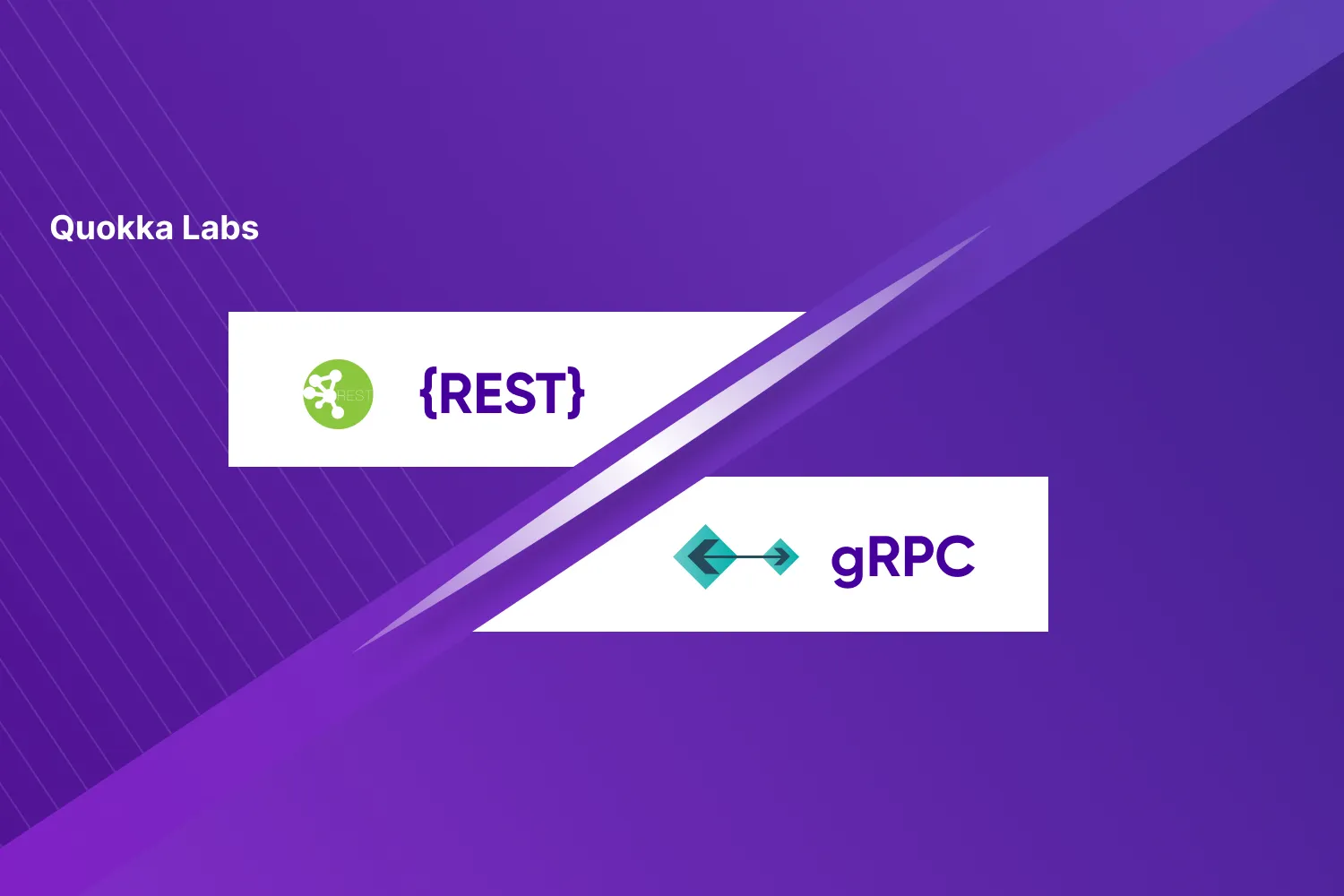Technology


3 min


REST APIs generally use JSON or XML message formats, while gRPC uses protocol buffers. To signal errors, REST APIs use HTTP status codes, while gRPC uses error codes.

By Vinamra Singh
07 Jul, 2022
In today's time, most business projects need the use of APIs in their technology. APIs traverse communication between services that might address a single or complex system. It can dwell on single or multiple machines, networks, or languages.
Many tech advancements address the inter-service communication requirements of a distributed system, such as REST, SOAP, GraphQL,gRPC, etc.
The REST API has been a pillar of web programming for quite a while. Most developers are familiar with REST. It is used significantly worldwide and in amateur tutorials on HTTP protocol. So, of course, new devs accepted REST.
But nowadays, gRPC API has begun encroaching on the web development area. While REST is a lean approach, gRPC is a commendable competitor. gRPC offers elite execution, type contacts, and magnificent tooling.
There is much info available on the internet, and it isn't easy to sort everything out about gRPC and REST APIs. It's normal for developers of new APIs to battle choosing an ideal API. For new developers, the issue is far more atrocious.
As per stats, gRPC is seven times quicker than REST when receiving data and ten times faster than sending data for a particular payload.
In this blog, we will compare API protocol between REST and gRPC and when to choose gRPC over RESTs.
This blog post also contains:
REST stands for Representational State Transfer . It provides rules on the most proficient method to create web APIs. Yet, that is a bunch of rules, but it doesn't attempt to enforce anything.
While using REST APIs, the reaction from the backend data gets passed to the user through the JSON or XML format. In general, this model follows HTTP protocol . RPC design chooses several HTTP thoughts while keeping up with the RPC model.

Most APIs get executed by mapping the APIs to a similar HTTP protocol despite the model use (RPC or REST).
When the REST API is available, each service coordinates the microservice application. It can get introduced to the client/users as an asset accessed through the HTTP commands.
RPC stands for Remote Procedure Call. It uses a client-server model.
It’s a software communication protocol a program uses to request a service from another.
The requesting server( i.e., the client) requested a message interpreted by the RPC. Later on, it shipped off another server. When the server gets the solicitation/request, it sends the response back to the client. The server handles this call; the client gets obstructed.
The message passed inside the servers. Further, RPC permits the client to request a function in a specific format. The client can get the reaction in the same configuration.
The technique for presenting a call with RPC API gets tracked down in the URL. RPC upholds far-off method calls both in nearby and conveyed environments.
Like a REST API, RPC establishes the guidelines of connection and how a user can submit requests. RPC requires conjuring techniques that convey and communicate with the services.
In 2015, Google developed gRPC as an extension of the RPC framework to connect various microservices. In the early phase, it associates with Google’s internal infrastructure. Then, it was made open-source and regulated for community use.
gRPC stands for Google Remote Procedure Call . and it's based on the RPC protocol and follows an RPC API's implementation that uses HTTP 2.0 protocol. But, HTTP didn't present to the API developer or the server.
It allows the client and server applications to communicate and develop connected systems.
During its initial phase, top Companies used it for many cases like web, mobile, and IoT support. Later in 2017, due to its popularity, it become Cloud Native Computing Foundation (CNCF) .
Leading tech firms like Google, Netflix, Cisco, & Dropbox have adopted gRPC. This framework relies on HTTP/2, protocol buffers, and others to ensure API security, performance, and scalability.
Hence, there is no worry about the RPC concepts getting mapped to HTTP, which reduces complexity. This innovation follows an RPC API's execution that utilizes the HTTP 2.0 protocol. But, HTTP isn't introduced to the API developers or the server.
gRPC aims to transfer data while depending on services, its layout, and also tends to empower them.
Besides, it communicates the RPC API model in an IDL (interface description language ). IDL offers an easier way to decide on remote procedures. The IDL utilizes Protocol Buffers to interface and constructs the payload messages.
Now, We have an overview of gRPC and REST; let's look at their main differences in detail.

In the REST API, a cross-language makes web services adaptable, and versatile. The most vital benefit of REST API is that it doesn't have to set up a client.
Hence, you must settle on decisions to the server address, dissimilar to gRPC. It's simple for developers to decide whether the client inputs are sent to the server and back.
But, you can use gRPC as a cross-language if you have composed a web service, making it versatile and scalable. gRPC utilizes a protocol buffer for information serialization. It makes the payloads quicker, smaller, and more transparent. This way, gRPC uses an HTTP 2 to help high-scale execution and uses binary data rather than text.
It is workable to switch off the message compression utilizing the gRPC. You can send a picture that is already compressed instead of compressing it once more. gRPC is like a type-safe; this requires excellent investment & time.
REST API gets upheld because each microservices depends on respect to the REST APIs as magic. But looking at the features that gRPC APIs offer, developers consider it a future.
Let's compare Rest vs gRPC from various perspectives.
REST APIs follow a request/response model of communication based on HTTP 1.1. But, if a microservice gets client requests, the model deals with each proposal and eases the whole system framework.
REST APIs also get created on HTTP 2. Still, the request/response model continues as before. But REST APIs prohibit HTTP 2 benefits like streaming and bidirectional help.
gRPC does not face a similar obstacle. It's built on HTTP 2 and follows a client-response communication model. It receives requests from clients and handles them by streaming data. It can also run unary interactions like those built on HTTP 1.1.
This viewpoint is one of the best REST API benefits over gRPC. From one perspective, REST gets support from all browsers.
But, gRPC is still very restricted about browser support. It requires gRPC-web and an intermediary proxy layer to perform changes between HTTP 1.1 and HTTP 2.
Hence, gRPC turns out to get used for internal and private systems. Internal and remote systems are API programs within backend data and app functionalities.
As mentioned above, gRPC utilizes Protocol Buffer to serialize payload information. This arrangement is lighter, empowers a packed, and diminishes the message's size. Further, the Protocol Buffer is binary. It serializes and deserializes organized data to impart and communicate. The messages change from Protobuf (Protocol Buffers) to the client’s programming language.
Google developed Protobuf or Protocol Buffer for internal use. It provided a code generator for various languages. The design goal for Protobuf is to make it simple and faster than XML. Google mainly uses it for storing and interchanging all types of structured data. This method is a basis for the RPC system used for all intermachine communication.
In contrast, REST depends on JSON or XML configurations to send and get information/data. Even though it is not mandatory, JSON is the most famous because of its adaptability and capacity. JSON sends dynamic information without following a strict system. One more advantage of using JSON is its human-comprehensibility level. Generally, Protobuf can't contend with it yet.
JSON isn't as lightweight or quick on information/data transmission. The justification for that lies in that while using REST. JSON should get serialized and transferred to the programming language.
Dissimilar to gRPC, REST API doesn't give in-build code generation highlights. Developers should use a third-party tool like Swagger or Postman to deliver code for API demands.
gRPC has local code generation highlights because of its protocol compiler. It is viable with a few programming dialects. And valuable for microservices systems. This coordination of different administrations gets created in various dialects and platforms. The implicit code generator likewise facilitates creating SDK (Software Development Kit).
REST APIs have been the most favored application integration decision for a a long time if you are building an interior or an external system.
REST API denotes its significance when the system needs a fast integration speed. it also normalization of HTTP connections. Alongside third-party tools' help, REST APIs are essential for app integration and other web services.
gRPC APIs are the most used web services to create an internal system close to outer clients. With unique qualities, we can utilize gRPC in part of the following conditions:
Despite the many benefits gRPC offers, it has one major demerit, i.e., low browser compatibility. Thus, gRPC is a bit limited to internal and private systems. This means gRPC is restricted to interior/confidential frameworks.
REST APIs might have their demerit, as we have discussed. Yet REST APIs stay the most known for interfacing microservices-based systems. Besides, REST follows the HTTP protocol and offers all-inclusive help.
APIs in the developed market empowers you for quicker app development with advanced technologies. You can construct better items while standing apart from the opposition by making the right APIs for your business. To install the API to trade, you must ensure that you can handle end-to-end services migrations and development from Quokka Labs.
gRPC provides many benefits. Dissimilar to REST, it can make the most out of HTTP 2, utilizing multiplexed streams and following the binary protocol. It offers execution benefits because of the Protobuf message structure. We should remember the in-build code generation features that empower a multilingual climate. These reasons make gRPC a more promising API style than REST. It's a matter of your personal choice. Both API protocols are excellent; we can't make any firm recommendations about which API protocol to use.
How to Use Augmented Reality in Retail to Boost Customer Engagement and Sales
By Sannidhya Sharma
5 min read
How to Use Augmented Reality in Accounting to Build Smarter Financial Apps
By Dhruv Joshi
5 min read
Top 10 Enterprise App Development Companies for Scalable Business Solutions
By Dhruv Joshi
7 min read
How to Build a Scalable Video Streaming App Like Netflix: A Step-by-Step Guide
By Dhruv Joshi
5 min read

Technology


5 min
Augmented reality in retail helps brands drive sales and reduce returns by transforming how customers discover, try, and buy products. This blog is your guide to using AR strategically, from choosing the right use cases to launching cost-effective AR experiences that delight customers and differentiate your brand.


Technology


5 min
The demand for high-quality video streaming apps has exploded, and it's not just Netflix leading the charge anymore. From niche platforms to corporate media ventures, businesses everywhere are realizing the massive opportunity in OTT app development to launch their own video streaming application.


Technology


5 min
The demand for video streaming apps has exploded in recent years, driven by faster internet, affordable smartphones, and a content-hungry audience. From binge-watching TV shows on OTT platforms to engaging with creators in real-time through streaming apps, users today want instant, seamless, and personalized experiences. But here's the thing, not every streaming app makes it big. Only a few rise to the top. So, what sets them apart?


Feeling lost!! Book a slot and get answers to all your industry-relevant doubts